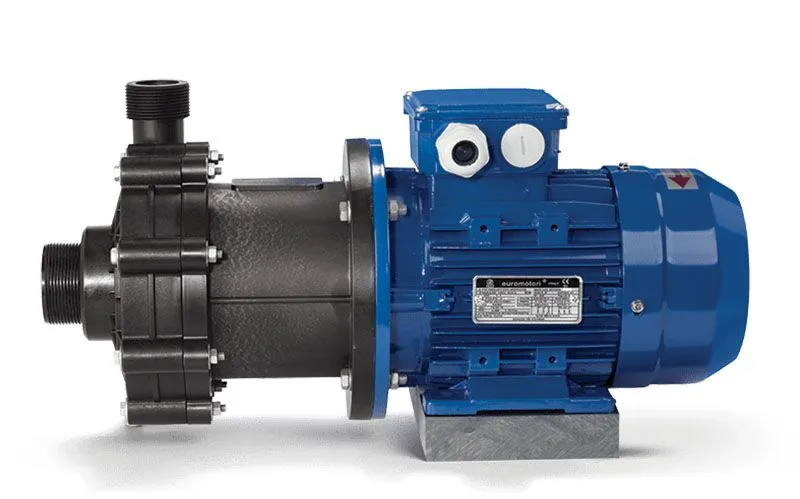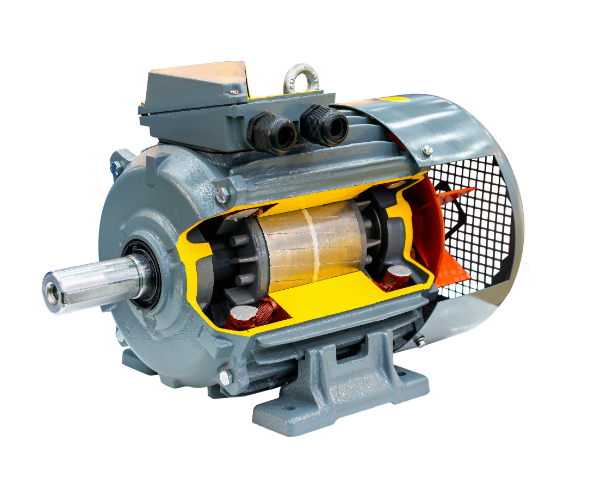It is due to higher efficiency, lower operating costs, superior reliability, smooth operations, compact design, improved power factor, and easy maintenance. It is mainly because three-phase motors are able to raise energy utilization through the balanced load of current and optimal power transformation and decrease the rate of energy waste. In the process of industrial production, three-phase motors start up smoothly with no impact and operate continuously, which reduces the wear and tear of parts and lowers the rate of mechanical failure; it has low maintenance costs and is suitable for work with heavy loads and long time.
Higher Efficiency
Among all the electric motors used in industry, three-phase motors rank among the most efficient. Within a power system, three-phase current possesses both spatial and temporal balance; therefore, three-phase motors run more effectively. Three-phase motors are far more effective compared to single-phase motors because of equal distribution of current loads and optimum conditions of motor design.
There is a uniform distribution of power across the three phases, with minimal fluctuations and pulsations in current. It leads to lower energy loss during the operation of the motor. Three-phase motors are more efficient at their startup stages compared to single-phase motors. The current fluctuations are larger in single-phase motors, which reduces efficiency and builds large starting currents that sometimes cause unnecessary impact on the motor as well as on the power grid. Regarding this, three-phase motors have lesser current fluctuations so that when a motor starts, the load increases smoothly with less energy loss and more efficient power performance.
Their power factor during the time of running under load is higher, which enables three-phase motors to give stable output with less energy consumption, thereby reducing demand on the grid and decreasing overall system load. Doing so will effectively promote the conversion of power to reduce operating costs and equipment failure due to overheating and prolong service life.
Lower Operating Costs
In real-world applications, the advantages of three-phase motors in energy savings render them economically viable. Probably, the cost of acquisition and installation for a three-phase motor may well be higher than that of a single-phase motor; eventually, its advantages in energy consumption, maintenance, and failure rates will ensure drastic reduction of the overall operating cost.
Energy consumption by three-phase motors is more effective, with less energy loss during their operation. The balancing of the load and small fluctuations of current improve the energy conversion efficiency in three-phase motors compared to single-phase motors. Moreover, three-phase motors have a relatively high efficiency in energy conversion under heavy loads, particularly for high-power applications.
Since the three-phase motor reduces fluctuations in currents, its power consumption will remain almost constant, hence reducing energy losses. In the case of huge equipment or continuous production lines, three-phase motors can keep their stability in operation without consuming any more power. Too large an alternating current in production may make the motor overheat and vibrate, leading to a shortened life-span, often inviting higher costs associated with maintenance and repair. Stability in the operation of a three-phase motor minimizes these unnecessary current fluctuations, greatly reducing energy loss.
With three-phase motors, the waveforms of current are much more regular both at start-up and during operation. As a result, it reduces peak starting currents compared to single-phase motors. Thereby, it reduces stress on the power grid and the motor itself, consequently preventing possible excessive consumption of power that would further damage the equipment. In this case, three-phase motors, at the instance of startup with heavy loads, result in smoother power requirements that reduce the possibility of overload on the grid or even failure of the motor itself, further reducing maintenance costs and periods of downtime.

Reliable Performance
Especially, three-phase motors are much more reliable when it comes to the heavy-load and long-duration operating environments. Working with three phases of current, the power output of a three-phase motor is much more even and effectively avoids overload caused by current fluctuations. Compared with single-phase motors, three-phase motors operate much more smoothly and provide more reliable power output in complicated and severe environments.
The three-phase motor adapts to the variation of the load by maintaining the output of the motor constant. Even when the variation of load is sudden, the current of the motor is altered very rapidly to avoid overloading at the time of starting or during high load conditions. This also guarantees excellent stability and reliability of a three-phase motor even in high-load operating environments facing frequent start-stop activities.
In the design of three-phase motors, this usually gives way to better resistance to overload. Due to the uniform current distribution in the stator windings, the heat that is developed within the motor is lower; hence, its adverse impact due to overheating decreases. Thus, the three-phase motors are able to work without stops over a very long period of time, and since the waveform of the current flowing therein is considerably smooth, wear and tear of parts inside the motor are reduced, thereby minimizing their need for constant maintenance.
The reliability of three-phase motors is further reflected by their low failure rate. With the distribution of load due to current being even and the forces applied to the components uniformly, overload, overheating, and electrical failures are minimized, hence the running of the motor steadily for longer periods.
Smooth Operation
Another important difference between the three-phase motors and the single-phase motors is their even run. Because the three-phase power is coordinated, the current output of a three-phase motor is extremely even, both in space and time, which not only prevents instability caused by the fluctuation of the current but also makes it run much smoother, causing less vibration and noise.
From starting up and going to stop, besides long running periods, the smoothness of operation of the motor is evident. Three-phase motors are designed in a way that during continuous operation, one does not face a possibility of stoppage or loss of efficiency due to unstable current or power fluctuations in the grid. Unlike single-phase motors, three-phase motors automatically balance the load during coordinated current phases, thereby reducing damage due to vibration and instability.
It may also reduce equipment vibration and noise, which reduces environmental impact during production. It will be especially important in areas where noise is a concern, such as in medical or laboratory equipment. Noise and vibration are reduced due to the three-phase motors, at the same time continuing to drive production lines smoothly and stably. Thus, this avoids the mechanical wear and failure that results from unbalanced currents.
The design of three-phase motors also effectively suppresses the effect of current fluctuations, preventing electrical disturbances and mechanical strains during long-term operation. The feature of smooth operation prolongs the working life of the motor and reduces the frequency of maintenance or changing of parts.
Compact Design
Since three-phase motors are compact, by design, they are the best to be applied where there is limited space. A three-phase motor of equivalent power is usually more compact compared to a single-phase motor; under the same conditions, it provides the same power output in a smaller space. Most industrial applications involve tight equipment layouts; because of their compact nature, three-phase motors can perform efficiently even in tight spaces.
Three-phase motors are designed with optimization in their size and weight. The precision construction makes the motor comparatively small and thus, might still be capable of providing a substantial amount of output power, finding wide application where the space is limited. This is even more so the case with mobile devices and automated production lines, where compact size and weight save businesses space to install equipment and transport said equipment, having less of a footprint.
It also makes maintenance more convenient with a more compact design. The smaller footprint reduces not only the space the equipment occupies but also makes access to and maintenance of the motor components easier, reducing time and effort spent on repairs. This is one of the major design advantages that make three-phase motors widely utilized in areas with confined spaces and high demands.

Improved Power Factor
The power factor is the relation between real and apparent power in any electrical system, important for judgment of energy efficiency. Due to the balanced load distribution, three-phase motors have a significant enhancement in their power factors and reduce the loss of ineffective electrical energy.
Three-phase motors have much smoother current waveforms that are capable of effectively reducing harmonic interference within the power grid. As a result, it cuts energy waste in the power grid. Three-phase motors achieve a higher power factor such that, under the same load, it could provide more useful power rather than wasting power as reactive energy. This reduces the cost of electricity trading between the power suppliers and users, while helping the power grid carry less load and improving the overall energy efficiency.
This is because most industrial applications lead to the saving of money on electricity bills; it also saves users from monetary penalties imposed by the power companies due to low power factors. This saves massive amounts in electricity cost for large enterprises or factories—an added economic advantage.
Easier Maintenance
Three-phase motors are usually simpler in design, and their structure is optimized for maintenance ease. Due to this, three-phase motors require less maintenance and a failure rate lower than that of other electric motors. Therefore, it will also lower the frequency of maintenance, and hence the cost too.
In three-phase motors, the load distribution is uniform; hence, during operation, the wear rate of the components of the motor is less intensive. It corresponds to fewer maintenance interventions and obviously prolongs the service life of the device. Generally speaking, when a failure occurs, diagnosing three-phase motors is rather easy because it can be found by simple verification of some key parameters such as current and voltage.
Three-phase motors have excellent stability and low failure rate, reducing downtime and work stress and costs in maintaining continuous and long-term production lines. Besides, the design of a three-phase motor usually agrees well with an automated control system, so their fault diagnoses and maintenance could be more intelligent to avoid misdiagnosis or delay that would have happened in manual maintenance.








